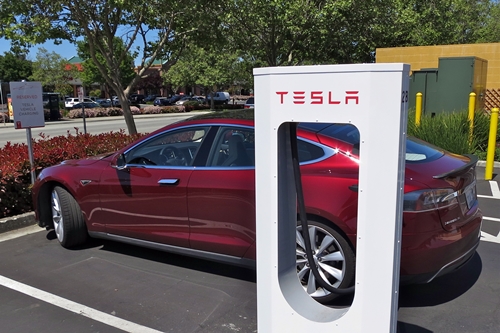30 October 2015. A research group at University of Cambridge in the U.K. unveiled a new design that meets some of the obstacles plaguing lithium-air batteries, considered a major improvement over lithium-ion batteries now used to power mobile devices, computers, and electric cars. The team from the lab of chemistry professor Clare Grey published its findings in today’s issue of the journal Science (paid subscription required).
Lithium-ion batteries use a negative electrode made of graphite, like the carbon in pencils, and a positive electrode of a metal oxide, in an electrolyte solution of lithium salt and organic solvent. The movement of lithium ions between the electrodes creates the electric current. The light weight of lithium-ion batteries makes them attractive for mobile devices and electric cars, where weight is a key issue. Plus, they hold their charge for extended periods and have no “memory effect” requiring a complete discharge, a problem with earlier battery chemistries.
Nonetheless, lithium-ion batteries have some drawbacks, particularly a low energy density requiring frequent recharging, which creates problems when applying the technology to electric cars and grid-scale storage for intermittent renewable energy sources. Lithium-air batteries, where the lithium ions react with oxygen to create the current, are considered a possible alternative, since in lab tests they demonstrate a maximum energy density up to 10 times that of lithium-ion batteries.
Creating a practical battery with 10 times the energy density of current batteries would give electric cars, for example, about the same range as gasoline-powered cars, thus alleviating the range-anxiety keeping many electric car buyers out of showrooms. But the lithium-air battery comes with its own set of issues, including lower stability and efficiency, as well as unexpected chemical reactions.
Grey and colleagues addressed these issues by changing the materials in the electrolyte and electrode. The lithium-air battery described in the paper adds lithium iodide and water to the electrolyte, generating lithium hydroxide rather than lithium peroxide in earlier versions. By producing lithium hydroxide, the battery shows increased stability from fewer unwanted chemical reactions after multiple charging/recharging cycles.
The new battery also has a negative graphene oxide electrode, a porous carbon material one atom in thickness. The pores in the graphene electrode capture larger lithium hydroxide crystals that increase the efficiency of the battery. The increased efficiency was measured by a sharply reduced voltage gap between charging and recharging, which translates to an efficiency of 93 percent, closer to lithium-ion batteries. The researchers report being able to recharge the battery so far more than 2,000 times.
Based on lab tests, the Cambridge team believes their battery could be configured for electric vehicles with one-fifth the weight and cost of today’s lithium-ion car batteries. However, some serious issues still need to be addressed, with practical versions still several years away. The lab battery uses pure oxygen rather than ordinary air that contains nitrogen, carbon dioxide, and water as well, all of which can react with metal electrodes. In addition, the metal electrode in the demonstrator grows thin metal fibers that can short-circuit or even explode the battery.
“What we’ve achieved is a significant advance for this technology and suggests whole new areas for research, says Grey in a university statement. “We haven’t solved all the problems inherent to this chemistry, but our results do show routes forward towards a practical device.”
Read more:
- Universal Wireless Charging Device Designed
- Navy Seeks Graphene Nanoribbons for Electricity Distribution
- Material Developed to Prevent Li-Ion Battery Fires
- Simple 3-D Graphene Construction Process Devised
- Solar Water-Splitting System Produces Hydrogen for Energy
* * *


 RSS - Posts
RSS - Posts
You must be logged in to post a comment.